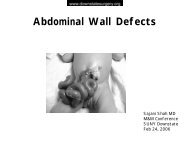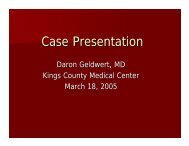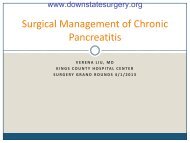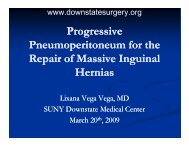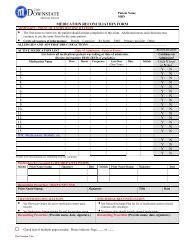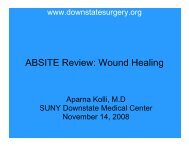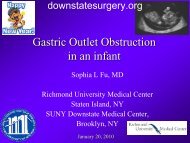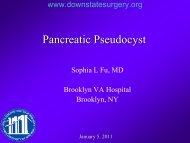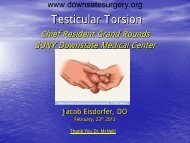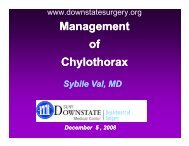Anterior Mediastinal Mass
Anterior Mediastinal Mass
Anterior Mediastinal Mass
You also want an ePaper? Increase the reach of your titles
YUMPU automatically turns print PDFs into web optimized ePapers that Google loves.
www.downstatesurgery.org<strong>Anterior</strong> <strong>Mediastinal</strong><strong>Mass</strong>Volodymyr Labinskyy M.D.SUNY Downstate UHB at LICH10/06/11
www.downstatesurgery.org• 57M who fell on 6/19/11 while standing and hadbrief loss of consciousness and went to hisPMD the following day who advised him to goto the local ER.• PMH/SH: DM, HTN, BPH, hyperlipidemia• Home meds: Janumet, Nateglinide, Metoprolol,Enalapril, Exforge, Vytorin, Flomax, ASA andVit D.• Allergies: NKDA• Social Hx: 10 pack year ex-cigarette use• Family Hx: non-contributory
www.downstatesurgery.org• Screening studies: Colonoscopy in 2011, negative.Stress test 1/2011, negative.• Vitals: WT 75 kg, T 37.0 C, HR 65, BP 101/69, RR 16.O2 saturations 100% on room air.• General: Healthy-appearing male, in no apparentdistress.• Lungs: Clear to auscultation bilaterally.• Heart: Regular rate and rhythm without any murmurs,rubs or gallops.• Labs: within normal limits.
www.downstatesurgery.org
www.downstatesurgery.org
www.downstatesurgery.org
www.downstatesurgery.org• CT guided biopsy of the chest lesion (6/23/11):• Malignant epitheloid neoplasm, not otherwise specified.Differential diagnosis that includes seminoma andcarcinoma.• Immunohistochemical stains: 8/12/11• Both OCT4 and CD117 are negative.• Cam5.2 is negative as well.• In summary, no morphological or immunohistochemicalevidence to suggest a tumor of germ cell origin.
www.downstatesurgery.org• Testicular US (7/28/11): No suspicious testicularmass.• Laboratories (7/28/11): Alpha-fetoprotein 6.9 (slightlyelevated, it was 6.1 cutoff), beta hCG less then 2.0,and LDH 214.• PET scan (8/4/11): Malignant disease likely at least 3sites, the mediastinum at the level of the aortic arch; aretrocrural now a aortocaval lymph nodeapproximately at the level of the renal vein, and asmaller node posterior to the aorta just above thebifurcation.
www.downstatesurgery.org• Pulmonary function tests (8/4/11): FVC 4.05 (103% ofpredicted), FEV-1 3.39 (113% of predicted), DLCO91% of predicted, DLCO/VA 106% of predicted.
www.downstatesurgery.org
www.downstatesurgery.org
www.downstatesurgery.org• Yolk sac tumor 6.8 cm, encapsulated, composed ofpleomorphic cells, trabecular and endodermal sinuspatterns with Shiller-Duval bodies.• Immunostains: tumor cells are positive for SALL4,GPC3 and negative for CD117 and OKT4;• Positive for the cytokeratin stains CAM5.2 and AE 1-3.• Inked markers negative for tumor.• Lymph nodes:• seventeen reactive lymph nodes, negative for tumor (0/17).• Flow cytometry negative for B-cell or T-cell lymphoma.
www.downstatesurgery.org
www.downstatesurgery.org
www.downstatesurgery.org
www.downstatesurgery.orgTumors of the <strong>Anterior</strong>Mediastinum
www.downstatesurgery.orgThree-compartment division of the mediastinum as proposed by Shields.(From Shields TW. General thoracic surgery. 2nd ed. Philadelphia: Lea & Febiger;1983, with permission.)
www.downstatesurgery.org
www.downstatesurgery.org
www.downstatesurgery.org
www.downstatesurgery.orgComparison of adult vs. children for histologic types of mediastinal tumors.Shin-Ichi Takeda and all., Clinical Spectrum of Primary <strong>Mediastinal</strong> Tumors:A Comparison of Adult and Pediatric Population sat a Single Japanese Institution;Journal of Surgical Oncology 2003;83:24–30
www.downstatesurgery.org <strong>Mediastinal</strong> lesions are symptomatic in 50%-75% of patients. 50% of all mediastinal lesions are incidentaldiscoveries on chest x-ray or CT scan. Symptoms can be caused by local masseffects, systemic effects of tumor derivedhormones and peptides, or infection.
www.downstatesurgery.org
www.downstatesurgery.org
www.downstatesurgery.org
www.downstatesurgery.org Fewer than 5% of all germ cell tumors arefound in the mediastinum. Arise from primordial germ cells thatmigrate from the urogenital ridge into themediastinum and thymus gland duringembryogenesis Almost all are found in the anteriorcompartment.
www.downstatesurgery.org 50% of all mediastinal germ cell tumors arebenign (teratomas); peak incidence during the second through fourthdecades of life. Benign tumors are classified as epidermoidcysts, dermoid cysts (teratodermoids), ormature teratomas. Pluripotent stem cells Contain multiple tissue elements derived from oneor more of the three embryonic germ cell layers.
www.downstatesurgery.org Malignant tumors are further classified as: Seminomas or nonseminomatous lesions Much more common in men than women. 30% to 50% of malignant mediastinalgerm cell tumors are seminomas.
www.downstatesurgery.org Seminomas: almost exclusively found in men between theages of 20 and 40 years extensive local invasion. Extrathoracic disease is uncommon, withmetastatic spread occurring first throughregional lymphatics. Definitive diagnosis is made by FNA oropen biopsy.
www.downstatesurgery.org NSGCT includes embryonal cell carcinomas,teratocarcinomas, choriocarcinomas, and yolksac (endodermal sinus) tumors. aggressive, are more likely to metastasize toextrathoracic sites less sensitive to therapy. Most NSGCTs produce -HCG, AFP, or both,and more than 90% of patients have elevatedlevels in their serum. Primary therapeutic modality is platinum-basedchemotherapy.
www.downstatesurgery.org
www.downstatesurgery.orgTissue diagnosis is often, but not always,required before proceeding with therapy.Circumstances in which biopsy is indicatedinclude:(1) suspicion of a tumor that is treated primarilywith nonoperative therapy (e.g., lymphoma,NSGCT, or seminoma);(2) Evidence of local invasion that would requireresection and reconstruction of vital structures(e.g., involvement of the SVC by a large anteriormediastinal mass);(3) evidence of metastatic disease renderingresection inappropriate.
www.downstatesurgery.orgSurgical approaches to biopsy:1. Chamberlain Procedure (<strong>Anterior</strong>Mediastinotomy)2. Transcervical biopsy (CervicalMediastinotomy)3. Thoracoscopic Biopsy4. Extended Mediastinoscopy
www.downstatesurgery.orgConventional mediastinoscopy
www.downstatesurgery.orgExtended mediastinoscopy is an alternative for the anteriorsecondinterspace mediastinotomy which is more commonly usedfor exploration of mediastinal nodal stations..
www.downstatesurgery.orgEndoscopic Ultrasound with Fine NeedleAspiration
www.downstatesurgery.org The pure mediastinal germ cell seminomas areextremely radiosensitive and are treated with radiationtherapy. After radiation, about 80% of patients with pure seminoma arecured. Residual masses greater than 3 cm should be resected. Nonseminomas usually treated with three-drugchemotherapy (bleomycin, etoposide, and cisplatin). Surgical resection is reserved for a residual mass aftertreatment, with normalization of serum markers.
www.downstatesurgery.orgIndiana University reviewed their 25-year experience with treatedmediastinal nonseminomatous germ cell tumors in 158 patients.With a median follow-up of 34 months, they reported a 62%overall survival.Kesler KA, Rieger KM, Hammoud ZT, et al. A 25-year single institution experience with surgery forprimary mediastinal nonseminomatous germ cell tumors. Ann Thorac Surg 2008;85:371-8.Long-term disease-free survival was achieved in 54% of patientswith mediastinal NSGCT, most commonly by using inductionchemotherapy followed by consolidation surgery.Rodney AJ, Tannir NM, Siefker-Radtke AO, Liu P, Walsh GL, Millikan RE, Swisher SG, Tu SM,Pagliaro LC. Urol Oncol. 2010 Oct 6.



